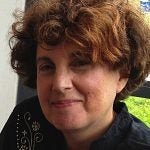Creating fairytales in the darkroom

Martha Weintraub
In its beginning, photography was considered truth, the documentation of historical events. But even in its earliest days the medium’s practitioners manipulated reality. Nineteenth-century French photographer Gustave Le Gray, for example, combined the clouds from one negative with the foreground of another to get the exposure just right.
Along came Jerry Uelsmann in the 1950s, experimenting with multiple enlargers and advanced masking, diffusing, burning and dodging techniques, to create imaginary images in the darkroom decades before the advent of Photoshop. Uelsmann’s work references Surrealists Rene Magritte, Max Ernst and Man Ray.
Uelsmann continues to practice traditional darkroom techniques while his wife, Maggie Taylor, employs Photoshop to create a surreal world. “Maggie and I have to invent our realities,” Uelsmann says.
Martha Weintraub, a protégé of Taylor and Uelsmann, also invents her own realities. She will be exhibiting her fantastical photographs in Story Hour at the Gallery at Chapin School through Jan. 30,.
As a former writer and editor of children’s textbooks, Weintraub explores her love of children’s literature in this exhibit. Some of the images she has created evoke classic children’s tales. She uses her granddaughters Natalie, 6, and Miranda, 3, as models – and that’s where reality ends.
In “Tea Party,” for example, we see a blonde girl in a wing chair – presumably Alice – seated at a table, set with a blue-and-white tea set, with another blonde girl in Mad Hatter millinery; sandwiched between them is a rabbit in a flannel shirt. The woody landscape behind them, with its arching branches, was shot at Grounds For Sculpture. Also from Alice in Wonderland is a scene of the young heroine talking to a hookah-smoking caterpillar on top of a mushroom. Yet another shows a blonde girl in a dress covered with hearts chasing a rabbit down a hole.
There’s Rapunzel – a little girl looks down from the top window of a stone tower, her blond tresses flowing to a lower parapet; Little Boy Blue (he sits alongside a haystack with his brass horn with sheep in the meadow and cow in the corn); and Little Red Riding Hood.
What makes Weintraub’s work believable are the shadows she adds to the objects and figures she layers into a scene, so it doesn’t look pasted together. “It took a long time to learn and lots of experimentation,” she says.
She demonstrates the creation of Little Red Riding Hood. “First I had to find a forest with a path that would work. Then I had to find the right wolf to approach the girl in the red dress.” The girl’s dress was initially white and had to be painted red, the path had to be added and, of course, a basket. “I darkened the path and added flowers to the basket. And I darkened her hair so it looks right for being in shadow.”
All of the images are surrounded by a frame of a scrolling line, suggestive of Victorian children’s book illustrations.
Weintraub has a strong role model. Her mother, 101, lives in the house Weintraub grew up in in Connecticut. Blind, she took up swimming five years ago and for her 100th birthday swam 20 laps in a 75-foot pool. “She loves to talk politics. She told her friends that life begins at 70 and began singing in the church choir and bowling when she turned that age.”
Following in her mother’s footsteps Weintraub, 72, took up riding a recumbent tricycle at 70 and completed 67 miles in a day at a competitive event in Salisbury, Maryland.
David Wurtzel – Weintraub’s husband — sits quietly in his study, working on his MacBook. When introduced, he tells a story Weintraub is too modest to recount. When Weintraub was first beginning on her path of creating a fantasy world, spending hours learning to master techniques, Wurtzel – he was her first photography instructor – thought she needed a mentor to discuss these new techniques. “Martha was doing terrific work, but didn’t have confidence in herself,” he says. “She was going in an aesthetic direction where she needed direction from someone higher up in the profession. So I thought of Jerry Uelsmann and Maggie Taylor. I found their e-mail and asked if they’d consider doing a critique of Martha’s work.”
At first the answer was a resounding no, but after Wurtzel persisted, Taylor conceded. Weintraub and Wurtzel flew to Gainesville, Florida, to meet them. “We sat at their kitchen table, and Jerry picked up one of Martha’s prints and said, ‘This is good stuff.’”
It was the boost Weintraub needed. Taylor taught her some techniques that day, and Weintraub signed up for her workshop.
It all began with a love of children’s books, and now Weintraub is creating her own.
______________________________________________________
The Artful Blogger is written by Ilene Dube and offers a look inside the art world of the greater Princeton area. Ilene Dube is an award-winning arts writer and editor, as well as an artist, curator and activist for the arts.
WHYY is your source for fact-based, in-depth journalism and information. As a nonprofit organization, we rely on financial support from readers like you. Please give today.





